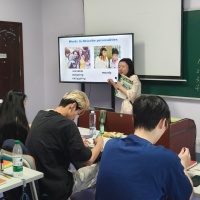春天有6个节气分别是什么?如何用英语表达?
中国传统24节气,每个季节各占6个节气。
The 24 traditional Chinese solar terms
中国传统24节气
春天有6个节气分别是:立春、雨水、惊蛰、春分、清明、谷雨,如何用英语表达?
一、立春
the Beginning of Spring丨1th Solar Terms
立春节的到来意味着严冬的结束。此时柳萌黄枝,水泛新绿,万物生长的春季已经到来。
立春节后,植物转绿,焕发勃勃生机。人们可以清楚地注意到白天的时间变得更长,天气也愈发温暖了。
After that everything turns green and becomes full of vigor. People clearly can notice that daytime becomes longer and the weather gets warmer.
春晓
——孟浩然
春眠不觉晓,
处处闻啼鸟。
夜来风雨声,
花落知多少。
A Spring Morning
— Tr. 许渊冲
This spring morning in bed I’m lying,
Not to awake till birds are crying.
After one night of wind and showers,
How many are the fallen flowers!
二、雨水
好雨知时节,当春乃发生
Rain Water丨2th Solar Terms
雨水是中国传统二十四节气(the 24 traditional Chinese solar terms)中的第二个节气。
“雨水”标志着降雨量的增多和气温的回升。雨水节气来临之际,盛春之景开始勃发:河水解冻,大雁北归,草木转绿。
Rain Water signals the increase in rainfall and rise in temperature. With its arrival, lively spring-like scenery starts blossoming: the river water defreezes, wild geese move from south to north, and trees and grass turn green again.
关于雨水节气的小知识
01.春雨贵如油
春雨对农作物的生长极为重要,中国古代谚语中也有“春雨贵如油”的说法。
在北方地区,“春旱”是常见的。春季的降水量只占年平均降水量的10%-15%。因此,随着天气转暖,降雨增多,雨水节气就被视为灌溉农田的关键时期。
In northern China, the spring drought is common and the precipitation of this season accounts for only 10 to 15 percent of annual average rainfall. Therefore, Rain Water is considered as a key period for irrigation when the day gets warmer and rainfall increases.
02.倒春寒
倒春寒:return of cold spell
晚春时期常出现倒春寒现象,在此阶段要格外注意保暖。
三、惊蛰
蛰,是指动物入冬蛰伏土中的冬眠状态。惊蛰,即天上的雷声惊醒了沉睡的万物,所以惊蛰的英文表达为 Awakening of Insects
Awakening of Insects丨3th Solar Terms
中国传统农历将一年分为24个节气。今年的惊蛰是在3月5日。
The traditional Chinese lunar calendar divides the year into 24 solar terms. Awakening of Insects (Chinese: 惊蛰) falls on Mar 5 this year.
惊蛰气还有哪些文化习俗呢?
01.祭白虎
Offering sacrifices to the white tiger
祭白虎,就是画一只白虎在纸上,再在它的嘴上涂猪血或者猪油,意思是让它吃饱后不再咬人,避免坏运气和是非矛盾。
When practicing this old custom, people draw the white tiger on paper, and then smear pig's blood and pork on its mouth. This means the tiger is fed so that it would not bite people, avoiding bad luck and conflict.
02.打“小人”
Beating "villains"
人们经常指派特定的“女巫”(通常是一位老年妇女)去“打小人”。他们用剪出人形的剪纸,代表生活中的“小人”,“女巫”会用鞋子或其他工具去打“纸小人”,驱逐厄运。
People often assign a specific “witch” (usually an elderly woman) to "beat the villains". They use paper cut in the shape of humans to represent "villains" in their lives and the "witch" would use shoes or other tools to hit the paper to expel bad luck.
四、春分
春分的“分”有两个含义,一个是“昼夜平分”,在春分这天,太阳直射赤道,昼夜等长。
The Spring Equinox丨4th Solar Terms
“二分”之一的春分,最早的春秋时代的《吕氏春秋·十二月记》已有记载:分就是一半的意思。
The Spring Equinox is one of "two equinox", the earliest recorded by《Mister Lv's Spring and Autumn Annals》in the Spring and Autumn period:Equinox means half.
春分节气还有哪些文化习俗呢?
01.燕归来
如古话所言,燕子会在“一候”的时候飞回北方;滚滚春雷则发生在“二候”;到了“三候”,闪电会频繁出现。这种划分揭示了春分的气候特点。
As the old saying goes, swallows fly back to the North in the first hou; thunder cracks the sky in the second hou; lightning occurs frequently in the third hou, which vividly reveals the climate feature during the Spring Equinox.
02.立鸡蛋
人们认为,如果有人能将鸡蛋竖立起来,他将会在未来交好运。也有些人认为,春分当日是玩这个游戏的最佳时机,因为在这天,地球的地轴与地球绕太阳公转的轨道平面处于一种相对平衡状态,这使得鸡蛋更容易被立起来。
It is believed that if someone can make the egg stand, he will have good luck in the future. Some believe that the Spring Equinox is the best time to practice this game because on this day the axis of the earth is relatively balanced against the orbital plane of the earth’s rotation around the sun, which makes it easier to erect an egg.
五、清明
Pure Brightness丨5th Solar Terms
还有一种说法:因“清”“明”二字皆为描述天气的词语,所以“清明”的英语表达为Clear and Bright。
清明在节气上代表天清地明的意义。清明是中国传统历法二十四节气中第五个节气,也是二十四节气中唯一演变成节日的节气。
On the solar term, Pure brightness represents the meaning of the nurture clean and bright. Pure brightness is the fifth solar term in the traditional Chinese calendar and the only one that has become a festival.
清明有哪些习俗呢?
01.清明祭祖:worshiping ancestors
扫墓和献上供品对逝者表示敬意,是两种纪念逝去亲友的重要习俗。为表示对逝者的关怀,墓边的杂草被清除并盖上新鲜的土壤。逝者最喜欢的食物、酒和筷子连同纸钱一起被供奉在墓边。
Cleaning the tombs and paying respect to the dead with offerings are the two important practices to remember late relatives. Weeds around the tomb are cleared away and fresh soil is added to show care for the dead. The dead person's favorite food, wine and chopsticks are offered on their tombs, along with paper money.
02.寒食节:Cold Food Festival
唐代诗人沈佺期在《寒食》一诗中写道:“普天皆灭焰,匝地尽藏烟。”读罢顿觉清冷之气扑面而来。
相传寒食节是“春秋五霸”之一的晋文公为纪念忠臣介子推而设立的。
03.春游
清明踏青不远行
The tomb-sweeping day for an outing
04.放风筝
古代称“纸鸢”《韩非子》中有记载,距今两千多年。
Kite flying, called the ancient 《Han Feizi 》 records paper kite, more than 2,000 years ago.
《清明》
(唐)杜牧
清明时节雨纷纷,
路上行人欲断魂。
借问酒家何处有?
牧童遥指杏花村。
A drizzling rain falls like tears on the Mourning Day;
The mourner's heart is going to break on his way.
Where can a wineshop be found to drown his sad hours?
A cowherd points to a cot 'mid apricot flowers.
(许渊冲 译)
六、谷雨,又是一年春尽时
这是24节气中的第6个节气,也是春季最后一个节气。
Grain Rain丨6th Solar Terms
雨生百谷,润物无声。至此,春渐远,夏将至,万物一片生机。
谷雨是第六个节气,也是春季最后一个节气。
Grain Rain is the sixth solar term and the last one in spring.
意义:这时田中的秋苗初插,作物的种子,最需要充足的雨水来灌溉。
Meaning: At this time the autumn seeds are sown in the fields,it most needs adequate rainfall to irrigate.
谷雨分三候:
Grain rain is divided into three times
初候浮萍开始生长,水温升高,浮萍在水面上郁郁生长。
First time ,the water starts to warm up and duckweed begins to grow.
二候斑鸠出现,因为斑鸠是迁徙性动物,寒冷的冬天一过去斑鸠就飞到相对温暖的地方来了。
Second time ,turtledoves appear because they are migratory animals and fly to warmer climes as soon as the cold winter is over.
三候戴胜鸟降落到生长茂盛的桑树上,因为谷雨时节桑树正是生长旺盛之际。
Third time,the hoopoe landed on the lush mulberry , which was thriving during the Grain Rain.









